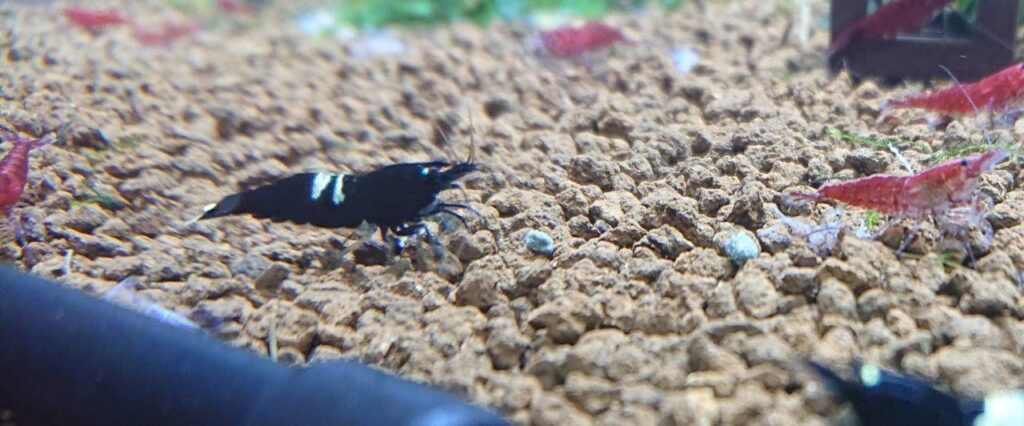Shrimp has become the most popular invertebrates for aquarium keepers in recent years, and it’s no wonder. These fascinating little creatures are hardy, colorful, and excellent tank cleaners! But can they be kept in cold-water tanks with no heater?
Most shrimp breeds can live in unheated tanks. They thrive in temperatures between 60 to 77°F (15 to 25°C) and can survive in temperatures several degrees above or below that range as well. However, shrimp kept in temperatures below 60°F (15°C) may be less active and won’t breed.
This article will list shrimp breeds that can live in unheated tanks. I will include details about each species’ basic needs, plus tips on keeping unheated tanks.

Shrimp Breeds That Can Live in Unheated Tanks
While there are hundreds of varieties of freshwater shrimp (dwarf shrimp) bred and sold for aquarium keepers, most come from three main genera:
- Caridina
- Neocaridina
- Palaemonetes
Shrimp species within each genus can typically interbreed with other species in the same genus, which is why they come in so many colorful varieties. However, the three genera cannot interbreed with each other and have somewhat different needs in terms of water parameters and environment.
Individual species’ needs will be listed below. However, all the shrimp on this list share a few of the same basic needs:
- Minimum 5-gallon (19-liter) tank
- Maximum 3 shrimp per gallon
- Lots of hiding places
- High-quality shrimp food daily
- Fresh blanched veggies weekly
Most Caridina, Neocaridina, and Palaemonetes species can be kept successfully in unheated tanks. The list below details the most popular and best beginner and intermediate species among them.
Cherry Shrimp (Neocaridina davidi)
The Cherry shrimp is hands down the most popular and hardy freshwater aquarium shrimp. They are sold under several names, including:
- Red Cherry shrimp
- Cherry shrimp
- Sakura shrimp
- Fire shrimp
These shrimps are peaceful and very vulnerable to predation, so they need to be kept with non-predatory tankmates. They breed easily and often (about every 30 days).
Cherry shrimp basic needs:
- Temperature between 60 to 77°F (15 to 25°C)
- Can survive in temperatures as low as 11.8°C (53°F) for short periods
- pH of 6.2 to 8.0
- General hardness of 4 to 8
- kH (carbonate hardness): 3 to 15
- TDS (total dissolved solids): 150 to 250
Other Varieties of Neocaridina davidi
It may come as a surprise, but Cherry shrimp aren’t the only variety of Neocaridina davidi. In fact, there are dozens of popular “morphs” that are technically the exact same shrimp—just in a different color! They have almost identical basic needs and can be easily kept in the same tank.
Aside from red, these shrimp come in:
- Yellow
- Blue
- Orange
- Green
- Violet
- Chocolate
- Black
- White
- “Ghost” (colorless)
Some colors may come in more than one variety, such as blue dream (solid blue) or blue rili (striped/spotted, semi-translucent blue).
Amano Shrimp (Caridina multidentata)
Amano shrimp are another extremely popular and hardy species that can be kept in unheated tanks. These shrimps are excellent algae eaters and are ideal for planted tanks. They have semi-translucent bodies and grow up to 2 inches (5.08 cm) long.
While they are easy to keep, Amanos are notoriously difficult to breed. In addition, they can be semi-aggressive and should not be kept with small or slow-moving fish. They are also easily preyed upon by larger fish.
Here are the Amanos basic needs:
- Temperature between 65 to 85°F (18 to 29°C)
- pH of 6.5 to 8.0
- General hardness of 5 to 5
- kH (carbonate hardness): 1 to 10
- TDS (total dissolved solids): 80 to 450
Ghost Shrimp (Palaemonetes paludosus)
Ghost shrimp are usually sold as feeders for other aquatic creatures, so they are frequently bred and raised in less-than-ideal conditions. For this reason, they may die off more frequently than other shrimp at first.
However, given good water parameters and a stress-free environment, they can be incredibly hardy and easy shrimp to keep. They are also sometimes called glass shrimp because they have very translucent, colorless bodies.
Breeding is a little more complicated and requires a specialized tank, as ghost shrimp hatch in a vulnerable larval stage before maturing into their hard-bodied shrimp form.
Basic Ghost shrimp needs:
- Temperature between 65 to 82°F (18 to 27.5°C)
- pH of 7.0 to 7.8
- General hardness of 3 to 15
- kH (carbonate hardness): 3 to 15
- TDS (total dissolved solids): 150 to 200
Tangerine Tiger Shrimp (Caridina serrata)
Tangerine tiger shrimp are a little harder to find but quite easy to keep without a heater. These are the hardiest of all the tiger shrimp varieties (most of which are actually a different species, Caridina mariae).
Tangerine tigers breed quickly and easily, and they can interbreed with other Caridina species.
The following are the tangerine tiger’s basic needs:
- Temperature between 65 to 75°F (18 to 24°C)
- pH: 6.5 to 7.5
- General Hardness: 3 to 6
- kH (carbonate hardness): 1 to 2
- TDS (total dissolved solids): 150 to 250
Crystal Red Shrimp (Caridina cantonensis)
The Crystal red shrimp is another popular freshwater shrimp variety that can technically be kept in an unheated tank. However, this species is more sensitive to temperature and water fluctuations, so having a heater is still necessary if you live somewhere with rapid temperature changes.
Either way, these shrimp are not recommended for beginners.
Crystal red shrimp basic needs:
- Temperature between 62 to 76°F (16.5 to 24.5°C)
- pH: 5.8 to 7.4
- General Hardness: 4 to 6
- kH (carbonate hardness): 0 to 4
- TDS (total dissolved solids):100 to 200
This species also comes in other variations and cross-breed varieties like:
- Crystal black (black and white striped)
- Blue Bolt (white with blue head)
- Black Pinto (white with black head)
- Wine red (dark red with lighter extremities)
Tips for Unheated Shrimp Tanks
Freshwater shrimp are sensitive to rapid temperature fluctuations. Therefore, if you are going to keep your shrimp without a heater, the following tips are recommended.
- Use a larger tank. The larger the tank, the more slowly the water temperature changes.
- Keep the tank in a well-insulated building with constant heating/air conditioning. The temperature should be steady and moderate.
- Place the tank away from doors, vents, and windows. Avoid exposing it to drafts or direct sunlight.
- Use a tank cover/hood. This will also protect against evaporation.
Conclusion
There are quite a few shrimp breeds you can keep in an unheated tank. These include:
- Cherry Shrimp (Neocaridina davidi) and other variations
- Amano shrimp (Caridina multidentata)
- Ghost Shrimp (Palaemonetes paludosus)
- Tangerine Tiger Shrimp (Caridina serrata)
- Crystal Red Shrimp (Caridina cantonensis) and other variations
However, take care to protect the tank from abrupt temperature changes. You can do this by using a cover and keeping it in a temperature-controlled room away from drafts and direct sunlight.
Helpfull Sources
- What Are The Perfect Cherry Shrimp Water Parameters
- Do Cherry Shrimp Need Sunlight
- Can Any Kind of Shrimp Survive in Freshwater?
Sources
- Aquarium Breede: 3 Most Hardy Dwarf Shrimps for Beginners
- Aquarium Store Depo: 15 Types of Aquarium Shrimp (With Pictures).
- Aqueon: Freshwater Shrimp Care GuideThe Shrimp Farm: Red Cherry Shrimp
- Fishkeeping Wisdom: How to Keep a Fish Tank Warm Without a Heater
- The Shrimp Farm: Amano Shrimp Care Sheet
- The Shrimp Farm: Crystal Red Shrimp
- The Shrimp Farm: Ghost Shrimp
- The Shrimp Farm: Tangerine Tiger Shrimp

